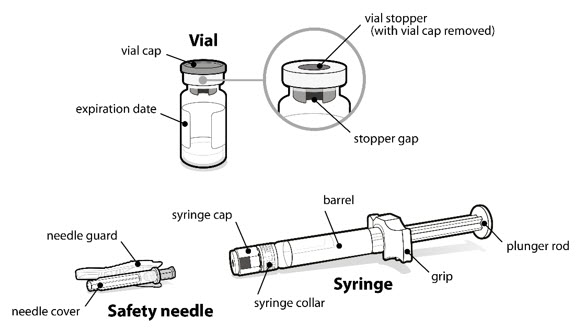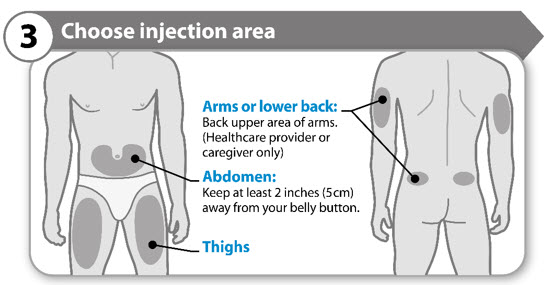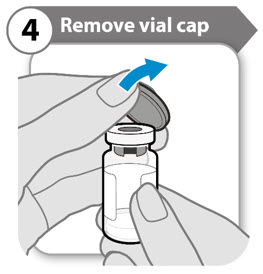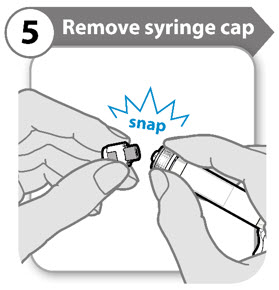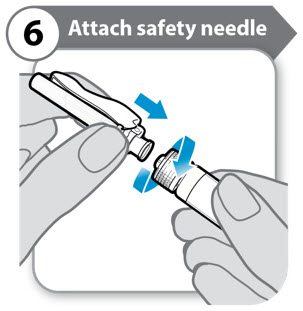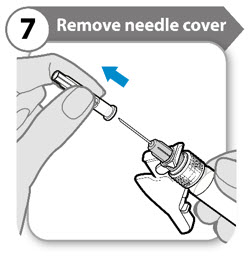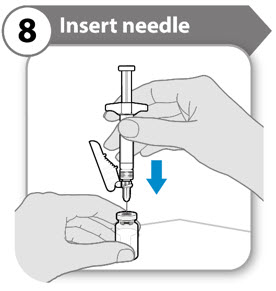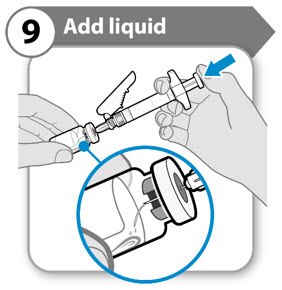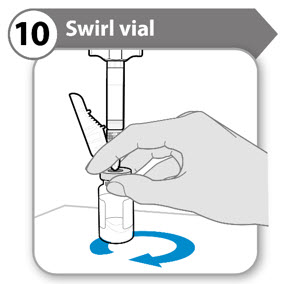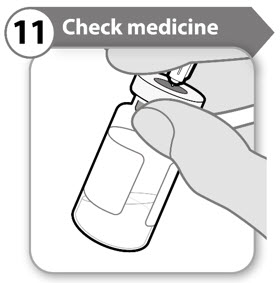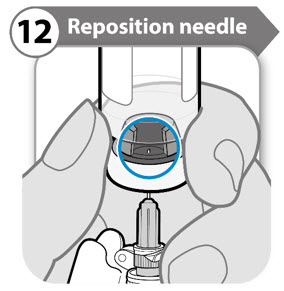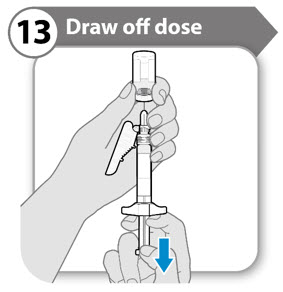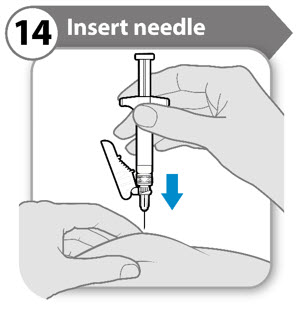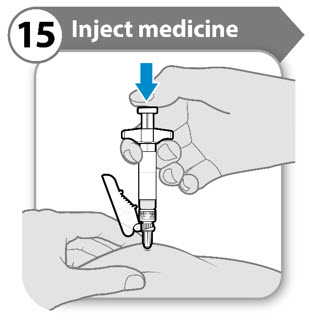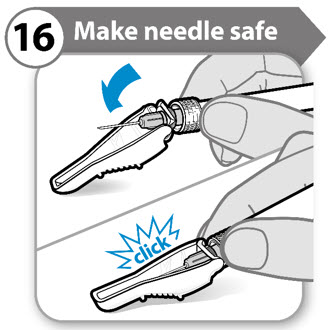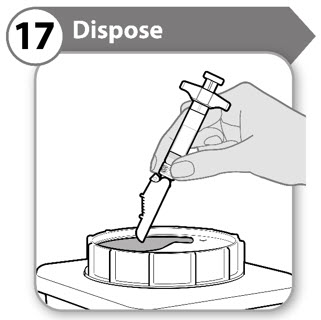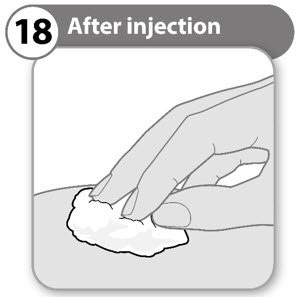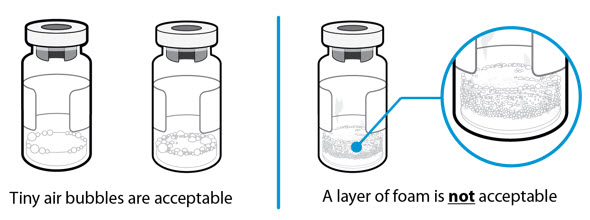SOMAVERT® WITH PREFILLED DILUENT SYRINGE Full Patient Information
(pegvisomant with PREFILLED DILUENT SYRINGE)
Full Patient Information
17 PATIENT COUNSELING INFORMATION
Advise the patient to read the FDA-approved patient labeling (Patient Information and Instructions for Use).
Inform patients (and/or their caregivers) of the following information to aid in the safe and effective use of SOMAVERT:
- •
- Not to use SOMAVERT if they are allergic to SOMAVERT or anything in it.
- •
- They will need blood testing to check IGF-1 levels and liver tests before and during treatment with SOMAVERT and that the dose of SOMAVERT may be changed based on the results of these tests.
- •
- SOMAVERT has not been studied in pregnant women and instruct them to notify their healthcare provider as soon as they are aware that they are pregnant.
- •
- It is not known whether SOMAVERT is excreted in human milk and instruct them to notify their healthcare provider if they plan to do so.
- •
- Pregnancy: Inform female patients that treatment with SOMAVERT may result in unintended pregnancy [see Females and Males of Reproductive Potential (8.3)].
Advise patients (and/or their caregivers) of the following adverse reactions:
- •
- The most common reported adverse reactions are injection site reaction, elevations of liver tests, pain, nausea, and diarrhea.
- •
- If they have liver test elevations they may need to have more frequent liver tests and/or discontinue SOMAVERT. Instruct patients to immediately discontinue therapy and contact their physician if they become jaundiced.
- •
- GH-secreting tumors may enlarge in people with acromegaly and that these tumors need to be watched carefully and monitored by MRI imaging.
- •
- Thickening under the skin may occur at the injection site that could lead to lumps and that switching sites may prevent or lessen this.
- •
- If they have diabetes mellitus, they may require careful monitoring and dose reductions of insulin and/or oral hypoglycemic agents while on SOMAVERT.
- •
- If they take opioids, they may need higher SOMAVERT doses to achieve appropriate IGF-1 suppression.
Inform patients (and/or their caregivers) about the storage options prior to reconstitution of the product [see How Supplied/Storage and Handling (16)].
Advise patients to follow the directions for reconstitution provided in the Instructions for Use. Include that spraying the diluent directly onto the powder may cause foaming and that shaking may induce denaturation (destruction) of the active ingredient (therefore do not shake).
U.S. License No. 1216
This product's labeling may have been updated. For the most recent prescribing information, please visit www.pfizer.com.
LAB-0782-4.0
This Patient Information has been approved by the U.S. Food and Drug Administration. | Revised: 7/2023 | |
PATIENT INFORMATION | ||
What is SOMAVERT? | ||
Before you use SOMAVERT, tell your healthcare provider about all of your medical conditions, including if you:
Tell your healthcare provider about all the medicines you take, including prescription and over-the-counter medicines, vitamins, and herbal supplements.
If you are not sure, ask your healthcare provider or pharmacist whether you take these medicines. | ||
How should I use SOMAVERT?
| ||
What are the possible side effects of SOMAVERT?
| ||
|
| |
| ||
|
| |
The most common side effects of SOMAVERT include: | ||
|
| |
These are not all of the possible side effects of SOMAVERT. For more information, ask your healthcare provider or pharmacist. | ||
How should I store SOMAVERT?
Keep SOMAVERT and all medicines out of the reach of children. | ||
General information about the safe and effective use of SOMAVERT. | ||
What are the ingredients in SOMAVERT?  U.S. License No. 1216
For more information, go to www.SOMAVERT.com or call 1-800-645-1280. | ||
INSTRUCTIONS FOR USE
SOMAVERT (SOM-ah-vert)
(pegvisomant)
for injection, for subcutaneous use
Read these Instructions for Use before you start using SOMAVERT and each time you get a refill. There may be new information. This leaflet does not take the place of talking to your healthcare provider about your medical condition or your treatment. Your healthcare provider should show you or a caregiver how to inject SOMAVERT the right way before you inject it for the first time.
SOMAVERT is available in two types of packaging:
- •
- One Day Package (containing one single-dose vial of SOMAVERT powder, a prefilled syringe, and a safety needle)
- •
- 30-Day Package (containing three intermediate cartons of 10 single-dose vials of SOMAVERT powder, 30 prefilled syringes, and 30 safety needles)
- •
- Before you mix the SOMAVERT powder and the liquid:
- o
- Store SOMAVERT in a refrigerator at 36 ºF to 46 ºF (2 ºC to 8 ºC).
- o
- The One Day Package and intermediate cartons in the 30-Day Package containing the SOMAVERT vials, may be stored at room temperature up to 77°F (25°C) for a single period of up to 30 days.
- o
- In the space provided on the carton, record the date when the carton was removed from the refrigerator and the discard date (30 days after removal from the refrigerator).
- o
- After the carton has been stored at room temperature, it should not be placed back into the refrigerator. If not used within 30 days at room temperature, the vials should be thrown away.
- •
- Throw away the SOMAVERT vials after the expiration date printed on the carton or the discard date, whichever is sooner.
- •
- The prefilled syringes may be stored at a temperature up to 86°F (30°C) until the expiration date printed on the carton. After that time, they should be thrown away.
- •
- Do not freeze SOMAVERT.
Important:
- •
- Do not share your SOMAVERT syringes or needles with other people. You may give other people a serious infection, or get an infection from them.
- •
- SOMAVERT comes in a vial as a white block of powder. You must mix SOMAVERT with a liquid (diluent) before you can use it. The liquid comes in a single-dose prefilled syringe labeled 'Sterile Water for Injection'. Do not use any other liquid to mix with SOMAVERT.
- •
- You must use the mixed SOMAVERT immediately after you mix it. If you have not used the mixed SOMAVERT immediately, throw it away.
Step 1. Things you need
- •
- A vial of SOMAVERT powder.
- •
- A prefilled syringe.
- •
- A safety needle.
You will also need:
- •
- A cotton ball.
- •
- An alcohol swab.
- •
- A sharps disposal container. See "Dispose" at the end of these instructions.
Step 2. Getting ready
Before you start:
- •
- Only mix SOMAVERT and the liquid when you are ready to inject your dose.
- •
- SOMAVERT One Day Package: If refrigerated, remove the package and allow it to come to room temperature in a safe place for at least 10 minutes before you need to use it.
- •
- SOMAVERT 30-Day Package: If refrigerated, remove a single vial from the intermediate carton and allow it to come to room temperature in a safe place for at least 10 minutes before you need to use it.
- •
- Do not heat the vial or syringe by using a heat source such as hot water or microwave. Let it warm up on its own.
- •
- Wash your hands with soap and water, and dry completely.
- •
- Peel open the packaging of the syringe and safety needle to make it easier to pick up each item as you prepare for your injection.
- •
- Do not use the syringe or vial if:
- o
- they are damaged or faulty
- o
- the expiration date has passed
- o
- it has been frozen, even if it has now thawed (syringe only)
Step 3. Choose injection area
- •
- Choose a different location within an area for each injection.
- •
- Avoid bony areas or areas that are bruised, red, sore or hard, or areas that have scars or skin conditions.
- •
- Clean the injection area with the alcohol swab as instructed by your healthcare provider.
- •
- Allow the injection area to dry.
Step 4. Remove vial cap
- •
- Remove the cap from the vial.
- •
- Throw the cap away. It is not needed again.
Caution: Do not let anything touch the vial stopper.
Step 5. Remove syringe cap
- •
- Snap off the syringe cap leaving the syringe collar in place. It may take more effort to snap off than you might expect.
- •
- Throw the syringe cap away. It is not needed again.
- •
- Keep the syringe upright to avoid leakage.
Caution: Do not let the end of the syringe touch anything when the syringe cap is off.
Step 6. Attach safety needle
- •
- Push down and twist the safety needle firmly onto the syringe as far as it will go.
Step 7. Remove needle cover
- •
- Fold the needle guard out of the way of the needle cover.
- •
- Carefully pull the needle cover straight off.
- •
- Throw the needle cover away. It is not needed again.
Caution: Do not let the needle touch anything.
Step 8. Insert needle
- •
- Push the needle through the center of vial stopper, as shown.
- •
- Support the syringe while the needle is in the vial stopper to prevent bending the needle.
Step 9. Add liquid
- •
- Tilt both the vial and syringe at an angle, as shown.
- •
- Push the plunger rod down slowly until all the liquid has emptied into the vial.
- •
- Caution: Do not squirt the liquid directly onto the powder. This creates foam. Foam makes the medicine unusable.
- •
- Do not withdraw the needle yet.
Step 10. Swirl vial
- •
- Support both the syringe and vial in 1 hand, as shown.
- •
- Gently and slowly swirl the liquid, sliding the vial in a circular motion on a flat surface.
- •
- Continue swirling the liquid until all the powder has fully dissolved.
Note: This may take up to 5 minutes.
Do not shake.
Step 11. Check medicine
- •
- Keeping the needle in the vial, look carefully at the medicine. It must be clear and free of particles.
- •
- Do not use if:
- o
- the medicine is cloudy or hazy
- o
- the medicine has any color at all
- o
- there are any particles or foam in the vial
- •
- If you have any doubts about your medication go to www.SOMAVERT.com or call 1-800-645-1280.
Step 12. Reposition needle
- •
- Turn the vial so that you can see the stopper gap, as shown.
- •
- Pull the needle down so that the needle tip is at the lowest point in the liquid. This will help you to draw off as much liquid as possible.
- •
- Check that the plunger rod has not moved. If the plunger rod has moved, then push it back all the way into the syringe. This ensures that all air is removed from the syringe before you draw off the dose.
Step 13. Draw off dose
- •
- Slowly pull back the plunger rod to withdraw as much medicine as possible from the vial.
Note: If you see air in the syringe, tap the barrel to float the bubbles to the top, and then gently push the bubbles out into the vial. - •
- Pull the needle out of the vial.
Step 14. Insert needle
- •
- Gently pinch the skin at the site of injection.
- •
- Insert the needle to its full depth into the pinched skin.
Step 15. Inject medicine
- •
- Push the plunger rod down slowly until the barrel is empty.
Note: Make sure you keep the needle in at full depth. - •
- Release the pinched skin and pull the needle straight out.
Step 16. Make needle safe
- •
- Fold the needle guard over the needle.
Gently apply pressure using a hard surface to lock the needle guard in place. - •
- Note: You will hear a click when the needle guard has been locked.
- •
- Put your used syringes in a FDA cleared sharps disposal container right away after use.
- •
- Do not throw away (dispose of) syringes in your household trash.
Note: If you do not have a FDA cleared sharps disposal container, please refer to the safe syringe disposal information on the right hand side of this leaflet.
Step 18. After injection
- •
- If necessary, use a clean cotton ball and press lightly on the injection area.
- •
- Do not rub the area.
QUESTIONS AND ANSWERS
What should I do if anything has accidentally touched the vial stopper?
- •
- Clean the vial stopper with a fresh alcohol wipe, and leave it to dry completely. If you are unable to clean the stopper, do not use the vial.
What should I do with the syringe if it has been dropped?
- •
- Do not use it even if it looks undamaged. Dispose of the syringe in the same way as a used syringe. You will need a replacement syringe.
How many times can I safely insert the needle into the vial stopper?
- •
- Only 1 time. Withdrawing and reinserting greatly increases the risk of needle damage, and will blunt the needle. This can cause discomfort and increases risk of skin damage and infection. There is also a risk you may lose some of the medicine.
Is it okay to shake the vial if the powder is not dissolving?
- •
- No. Never shake the vial. Shaking can destroy the medicine and create foam. The powder may take a few minutes to dissolve fully, so continue swirling the vial gently until the liquid is completely clear.
How can I tell if there is any foam in the vial?
- •
- Foam looks like a mass of small bubbles that float as a layer to the top of the liquid. Do not inject SOMAVERT if it has foamed.
How can I prevent the medicine from foaming?
- •
- Press the plunger very slowly so that the liquid gently runs down the inside of the vial. Do not spray the liquid directly onto the powder, because this creates foam. This will also reduce the swirling time and allow more of the medicine to be drawn off.
I can see some air in the syringe. Is this okay?
- •
- Tiny air bubbles in the liquid are normal and are safe to inject. However, it is possible to accidently draw air into the syringe, which should be removed before injecting. Bubbles or air gaps that float to the top of the liquid should be pushed back out into the vial.
Why can I not get all of the medicine out of the vial?
- •
- The shape of the vial means that a very small amount of the medicine will be left behind in the vial. This is normal. To ensure that only a trace of medicine remains, make sure the needle tip is as low as it can be in the vial when drawing off your dose.
What should I do if I have any doubts about my medicine?
- •
- For more information, go to www.SOMAVERT.com or call 1-800-645-1280.
Safe syringe disposal information
If you do not have a FDA-cleared sharps disposal container, you may use a household container that is:
- o
- made of heavy-duty plastic,
- o
- can be closed with a tight-fitting, puncture-resistant lid, without sharps being able to come out,
- o
- upright and stable during use, leak-resistant, and
- o
- properly labeled to warn of hazardous waste inside the container.
When your sharps disposal container is almost full, you will need to follow your community guidelines for the right way to dispose of your sharps disposal container. There may be state or local laws about how you should throw away used needles and syringes.
For more information about safe sharps disposal, and for specific information about sharps disposal in the state that you live in, go to the FDA's website at: http://www.fda.gov/safesharpdisposal
This Instructions for Use has been approved by the U.S. Food and Drug Administration.
U.S. License No. 1216
LAB-0784-3.0
Revised: July 2023
Find SOMAVERT® WITH PREFILLED DILUENT SYRINGE medical information:
Find SOMAVERT® WITH PREFILLED DILUENT SYRINGE medical information:
SOMAVERT® WITH PREFILLED DILUENT SYRINGE Quick Finder
Health Professional Information
Full Patient Information
Full Patient Information
17 PATIENT COUNSELING INFORMATION
Advise the patient to read the FDA-approved patient labeling (Patient Information and Instructions for Use).
Inform patients (and/or their caregivers) of the following information to aid in the safe and effective use of SOMAVERT:
- •
- Not to use SOMAVERT if they are allergic to SOMAVERT or anything in it.
- •
- They will need blood testing to check IGF-1 levels and liver tests before and during treatment with SOMAVERT and that the dose of SOMAVERT may be changed based on the results of these tests.
- •
- SOMAVERT has not been studied in pregnant women and instruct them to notify their healthcare provider as soon as they are aware that they are pregnant.
- •
- It is not known whether SOMAVERT is excreted in human milk and instruct them to notify their healthcare provider if they plan to do so.
- •
- Pregnancy: Inform female patients that treatment with SOMAVERT may result in unintended pregnancy [see Females and Males of Reproductive Potential (8.3)].
Advise patients (and/or their caregivers) of the following adverse reactions:
- •
- The most common reported adverse reactions are injection site reaction, elevations of liver tests, pain, nausea, and diarrhea.
- •
- If they have liver test elevations they may need to have more frequent liver tests and/or discontinue SOMAVERT. Instruct patients to immediately discontinue therapy and contact their physician if they become jaundiced.
- •
- GH-secreting tumors may enlarge in people with acromegaly and that these tumors need to be watched carefully and monitored by MRI imaging.
- •
- Thickening under the skin may occur at the injection site that could lead to lumps and that switching sites may prevent or lessen this.
- •
- If they have diabetes mellitus, they may require careful monitoring and dose reductions of insulin and/or oral hypoglycemic agents while on SOMAVERT.
- •
- If they take opioids, they may need higher SOMAVERT doses to achieve appropriate IGF-1 suppression.
Inform patients (and/or their caregivers) about the storage options prior to reconstitution of the product [see How Supplied/Storage and Handling (16)].
Advise patients to follow the directions for reconstitution provided in the Instructions for Use. Include that spraying the diluent directly onto the powder may cause foaming and that shaking may induce denaturation (destruction) of the active ingredient (therefore do not shake).
U.S. License No. 1216
This product's labeling may have been updated. For the most recent prescribing information, please visit www.pfizer.com.
LAB-0782-4.0
This Patient Information has been approved by the U.S. Food and Drug Administration. | Revised: 7/2023 | |
PATIENT INFORMATION | ||
What is SOMAVERT? | ||
Before you use SOMAVERT, tell your healthcare provider about all of your medical conditions, including if you:
Tell your healthcare provider about all the medicines you take, including prescription and over-the-counter medicines, vitamins, and herbal supplements.
If you are not sure, ask your healthcare provider or pharmacist whether you take these medicines. | ||
How should I use SOMAVERT?
| ||
What are the possible side effects of SOMAVERT?
| ||
|
| |
| ||
|
| |
The most common side effects of SOMAVERT include: | ||
|
| |
These are not all of the possible side effects of SOMAVERT. For more information, ask your healthcare provider or pharmacist. | ||
How should I store SOMAVERT?
Keep SOMAVERT and all medicines out of the reach of children. | ||
General information about the safe and effective use of SOMAVERT. | ||
What are the ingredients in SOMAVERT?  U.S. License No. 1216
For more information, go to www.SOMAVERT.com or call 1-800-645-1280. | ||
INSTRUCTIONS FOR USE
SOMAVERT (SOM-ah-vert)
(pegvisomant)
for injection, for subcutaneous use
Read these Instructions for Use before you start using SOMAVERT and each time you get a refill. There may be new information. This leaflet does not take the place of talking to your healthcare provider about your medical condition or your treatment. Your healthcare provider should show you or a caregiver how to inject SOMAVERT the right way before you inject it for the first time.
SOMAVERT is available in two types of packaging:
- •
- One Day Package (containing one single-dose vial of SOMAVERT powder, a prefilled syringe, and a safety needle)
- •
- 30-Day Package (containing three intermediate cartons of 10 single-dose vials of SOMAVERT powder, 30 prefilled syringes, and 30 safety needles)
- •
- Before you mix the SOMAVERT powder and the liquid:
- o
- Store SOMAVERT in a refrigerator at 36 ºF to 46 ºF (2 ºC to 8 ºC).
- o
- The One Day Package and intermediate cartons in the 30-Day Package containing the SOMAVERT vials, may be stored at room temperature up to 77°F (25°C) for a single period of up to 30 days.
- o
- In the space provided on the carton, record the date when the carton was removed from the refrigerator and the discard date (30 days after removal from the refrigerator).
- o
- After the carton has been stored at room temperature, it should not be placed back into the refrigerator. If not used within 30 days at room temperature, the vials should be thrown away.
- •
- Throw away the SOMAVERT vials after the expiration date printed on the carton or the discard date, whichever is sooner.
- •
- The prefilled syringes may be stored at a temperature up to 86°F (30°C) until the expiration date printed on the carton. After that time, they should be thrown away.
- •
- Do not freeze SOMAVERT.
Important:
- •
- Do not share your SOMAVERT syringes or needles with other people. You may give other people a serious infection, or get an infection from them.
- •
- SOMAVERT comes in a vial as a white block of powder. You must mix SOMAVERT with a liquid (diluent) before you can use it. The liquid comes in a single-dose prefilled syringe labeled 'Sterile Water for Injection'. Do not use any other liquid to mix with SOMAVERT.
- •
- You must use the mixed SOMAVERT immediately after you mix it. If you have not used the mixed SOMAVERT immediately, throw it away.
Step 1. Things you need
- •
- A vial of SOMAVERT powder.
- •
- A prefilled syringe.
- •
- A safety needle.
You will also need:
- •
- A cotton ball.
- •
- An alcohol swab.
- •
- A sharps disposal container. See "Dispose" at the end of these instructions.
Step 2. Getting ready
Before you start:
- •
- Only mix SOMAVERT and the liquid when you are ready to inject your dose.
- •
- SOMAVERT One Day Package: If refrigerated, remove the package and allow it to come to room temperature in a safe place for at least 10 minutes before you need to use it.
- •
- SOMAVERT 30-Day Package: If refrigerated, remove a single vial from the intermediate carton and allow it to come to room temperature in a safe place for at least 10 minutes before you need to use it.
- •
- Do not heat the vial or syringe by using a heat source such as hot water or microwave. Let it warm up on its own.
- •
- Wash your hands with soap and water, and dry completely.
- •
- Peel open the packaging of the syringe and safety needle to make it easier to pick up each item as you prepare for your injection.
- •
- Do not use the syringe or vial if:
- o
- they are damaged or faulty
- o
- the expiration date has passed
- o
- it has been frozen, even if it has now thawed (syringe only)
Step 3. Choose injection area
- •
- Choose a different location within an area for each injection.
- •
- Avoid bony areas or areas that are bruised, red, sore or hard, or areas that have scars or skin conditions.
- •
- Clean the injection area with the alcohol swab as instructed by your healthcare provider.
- •
- Allow the injection area to dry.
Step 4. Remove vial cap
- •
- Remove the cap from the vial.
- •
- Throw the cap away. It is not needed again.
Caution: Do not let anything touch the vial stopper.
Step 5. Remove syringe cap
- •
- Snap off the syringe cap leaving the syringe collar in place. It may take more effort to snap off than you might expect.
- •
- Throw the syringe cap away. It is not needed again.
- •
- Keep the syringe upright to avoid leakage.
Caution: Do not let the end of the syringe touch anything when the syringe cap is off.
Step 6. Attach safety needle
- •
- Push down and twist the safety needle firmly onto the syringe as far as it will go.
Step 7. Remove needle cover
- •
- Fold the needle guard out of the way of the needle cover.
- •
- Carefully pull the needle cover straight off.
- •
- Throw the needle cover away. It is not needed again.
Caution: Do not let the needle touch anything.
Step 8. Insert needle
- •
- Push the needle through the center of vial stopper, as shown.
- •
- Support the syringe while the needle is in the vial stopper to prevent bending the needle.
Step 9. Add liquid
- •
- Tilt both the vial and syringe at an angle, as shown.
- •
- Push the plunger rod down slowly until all the liquid has emptied into the vial.
- •
- Caution: Do not squirt the liquid directly onto the powder. This creates foam. Foam makes the medicine unusable.
- •
- Do not withdraw the needle yet.
Step 10. Swirl vial
- •
- Support both the syringe and vial in 1 hand, as shown.
- •
- Gently and slowly swirl the liquid, sliding the vial in a circular motion on a flat surface.
- •
- Continue swirling the liquid until all the powder has fully dissolved.
Note: This may take up to 5 minutes.
Do not shake.
Step 11. Check medicine
- •
- Keeping the needle in the vial, look carefully at the medicine. It must be clear and free of particles.
- •
- Do not use if:
- o
- the medicine is cloudy or hazy
- o
- the medicine has any color at all
- o
- there are any particles or foam in the vial
- •
- If you have any doubts about your medication go to www.SOMAVERT.com or call 1-800-645-1280.
Step 12. Reposition needle
- •
- Turn the vial so that you can see the stopper gap, as shown.
- •
- Pull the needle down so that the needle tip is at the lowest point in the liquid. This will help you to draw off as much liquid as possible.
- •
- Check that the plunger rod has not moved. If the plunger rod has moved, then push it back all the way into the syringe. This ensures that all air is removed from the syringe before you draw off the dose.
Step 13. Draw off dose
- •
- Slowly pull back the plunger rod to withdraw as much medicine as possible from the vial.
Note: If you see air in the syringe, tap the barrel to float the bubbles to the top, and then gently push the bubbles out into the vial. - •
- Pull the needle out of the vial.
Step 14. Insert needle
- •
- Gently pinch the skin at the site of injection.
- •
- Insert the needle to its full depth into the pinched skin.
Step 15. Inject medicine
- •
- Push the plunger rod down slowly until the barrel is empty.
Note: Make sure you keep the needle in at full depth. - •
- Release the pinched skin and pull the needle straight out.
Step 16. Make needle safe
- •
- Fold the needle guard over the needle.
Gently apply pressure using a hard surface to lock the needle guard in place. - •
- Note: You will hear a click when the needle guard has been locked.
- •
- Put your used syringes in a FDA cleared sharps disposal container right away after use.
- •
- Do not throw away (dispose of) syringes in your household trash.
Note: If you do not have a FDA cleared sharps disposal container, please refer to the safe syringe disposal information on the right hand side of this leaflet.
Step 18. After injection
- •
- If necessary, use a clean cotton ball and press lightly on the injection area.
- •
- Do not rub the area.
QUESTIONS AND ANSWERS
What should I do if anything has accidentally touched the vial stopper?
- •
- Clean the vial stopper with a fresh alcohol wipe, and leave it to dry completely. If you are unable to clean the stopper, do not use the vial.
What should I do with the syringe if it has been dropped?
- •
- Do not use it even if it looks undamaged. Dispose of the syringe in the same way as a used syringe. You will need a replacement syringe.
How many times can I safely insert the needle into the vial stopper?
- •
- Only 1 time. Withdrawing and reinserting greatly increases the risk of needle damage, and will blunt the needle. This can cause discomfort and increases risk of skin damage and infection. There is also a risk you may lose some of the medicine.
Is it okay to shake the vial if the powder is not dissolving?
- •
- No. Never shake the vial. Shaking can destroy the medicine and create foam. The powder may take a few minutes to dissolve fully, so continue swirling the vial gently until the liquid is completely clear.
How can I tell if there is any foam in the vial?
- •
- Foam looks like a mass of small bubbles that float as a layer to the top of the liquid. Do not inject SOMAVERT if it has foamed.
How can I prevent the medicine from foaming?
- •
- Press the plunger very slowly so that the liquid gently runs down the inside of the vial. Do not spray the liquid directly onto the powder, because this creates foam. This will also reduce the swirling time and allow more of the medicine to be drawn off.
I can see some air in the syringe. Is this okay?
- •
- Tiny air bubbles in the liquid are normal and are safe to inject. However, it is possible to accidently draw air into the syringe, which should be removed before injecting. Bubbles or air gaps that float to the top of the liquid should be pushed back out into the vial.
Why can I not get all of the medicine out of the vial?
- •
- The shape of the vial means that a very small amount of the medicine will be left behind in the vial. This is normal. To ensure that only a trace of medicine remains, make sure the needle tip is as low as it can be in the vial when drawing off your dose.
What should I do if I have any doubts about my medicine?
- •
- For more information, go to www.SOMAVERT.com or call 1-800-645-1280.
Safe syringe disposal information
If you do not have a FDA-cleared sharps disposal container, you may use a household container that is:
- o
- made of heavy-duty plastic,
- o
- can be closed with a tight-fitting, puncture-resistant lid, without sharps being able to come out,
- o
- upright and stable during use, leak-resistant, and
- o
- properly labeled to warn of hazardous waste inside the container.
When your sharps disposal container is almost full, you will need to follow your community guidelines for the right way to dispose of your sharps disposal container. There may be state or local laws about how you should throw away used needles and syringes.
For more information about safe sharps disposal, and for specific information about sharps disposal in the state that you live in, go to the FDA's website at: http://www.fda.gov/safesharpdisposal
This Instructions for Use has been approved by the U.S. Food and Drug Administration.
U.S. License No. 1216
LAB-0784-3.0
Revised: July 2023
Health Professional Information
Full Patient Information
Full Patient Information
17 PATIENT COUNSELING INFORMATION
Advise the patient to read the FDA-approved patient labeling (Patient Information and Instructions for Use).
Inform patients (and/or their caregivers) of the following information to aid in the safe and effective use of SOMAVERT:
- •
- Not to use SOMAVERT if they are allergic to SOMAVERT or anything in it.
- •
- They will need blood testing to check IGF-1 levels and liver tests before and during treatment with SOMAVERT and that the dose of SOMAVERT may be changed based on the results of these tests.
- •
- SOMAVERT has not been studied in pregnant women and instruct them to notify their healthcare provider as soon as they are aware that they are pregnant.
- •
- It is not known whether SOMAVERT is excreted in human milk and instruct them to notify their healthcare provider if they plan to do so.
- •
- Pregnancy: Inform female patients that treatment with SOMAVERT may result in unintended pregnancy [see Females and Males of Reproductive Potential (8.3)].
Advise patients (and/or their caregivers) of the following adverse reactions:
- •
- The most common reported adverse reactions are injection site reaction, elevations of liver tests, pain, nausea, and diarrhea.
- •
- If they have liver test elevations they may need to have more frequent liver tests and/or discontinue SOMAVERT. Instruct patients to immediately discontinue therapy and contact their physician if they become jaundiced.
- •
- GH-secreting tumors may enlarge in people with acromegaly and that these tumors need to be watched carefully and monitored by MRI imaging.
- •
- Thickening under the skin may occur at the injection site that could lead to lumps and that switching sites may prevent or lessen this.
- •
- If they have diabetes mellitus, they may require careful monitoring and dose reductions of insulin and/or oral hypoglycemic agents while on SOMAVERT.
- •
- If they take opioids, they may need higher SOMAVERT doses to achieve appropriate IGF-1 suppression.
Inform patients (and/or their caregivers) about the storage options prior to reconstitution of the product [see How Supplied/Storage and Handling (16)].
Advise patients to follow the directions for reconstitution provided in the Instructions for Use. Include that spraying the diluent directly onto the powder may cause foaming and that shaking may induce denaturation (destruction) of the active ingredient (therefore do not shake).
U.S. License No. 1216
This product's labeling may have been updated. For the most recent prescribing information, please visit www.pfizer.com.
LAB-0782-4.0
This Patient Information has been approved by the U.S. Food and Drug Administration. | Revised: 7/2023 | |
PATIENT INFORMATION | ||
What is SOMAVERT? | ||
Before you use SOMAVERT, tell your healthcare provider about all of your medical conditions, including if you:
Tell your healthcare provider about all the medicines you take, including prescription and over-the-counter medicines, vitamins, and herbal supplements.
If you are not sure, ask your healthcare provider or pharmacist whether you take these medicines. | ||
How should I use SOMAVERT?
| ||
What are the possible side effects of SOMAVERT?
| ||
|
| |
| ||
|
| |
The most common side effects of SOMAVERT include: | ||
|
| |
These are not all of the possible side effects of SOMAVERT. For more information, ask your healthcare provider or pharmacist. | ||
How should I store SOMAVERT?
Keep SOMAVERT and all medicines out of the reach of children. | ||
General information about the safe and effective use of SOMAVERT. | ||
What are the ingredients in SOMAVERT?  U.S. License No. 1216
For more information, go to www.SOMAVERT.com or call 1-800-645-1280. | ||
INSTRUCTIONS FOR USE
SOMAVERT (SOM-ah-vert)
(pegvisomant)
for injection, for subcutaneous use
Read these Instructions for Use before you start using SOMAVERT and each time you get a refill. There may be new information. This leaflet does not take the place of talking to your healthcare provider about your medical condition or your treatment. Your healthcare provider should show you or a caregiver how to inject SOMAVERT the right way before you inject it for the first time.
SOMAVERT is available in two types of packaging:
- •
- One Day Package (containing one single-dose vial of SOMAVERT powder, a prefilled syringe, and a safety needle)
- •
- 30-Day Package (containing three intermediate cartons of 10 single-dose vials of SOMAVERT powder, 30 prefilled syringes, and 30 safety needles)
- •
- Before you mix the SOMAVERT powder and the liquid:
- o
- Store SOMAVERT in a refrigerator at 36 ºF to 46 ºF (2 ºC to 8 ºC).
- o
- The One Day Package and intermediate cartons in the 30-Day Package containing the SOMAVERT vials, may be stored at room temperature up to 77°F (25°C) for a single period of up to 30 days.
- o
- In the space provided on the carton, record the date when the carton was removed from the refrigerator and the discard date (30 days after removal from the refrigerator).
- o
- After the carton has been stored at room temperature, it should not be placed back into the refrigerator. If not used within 30 days at room temperature, the vials should be thrown away.
- •
- Throw away the SOMAVERT vials after the expiration date printed on the carton or the discard date, whichever is sooner.
- •
- The prefilled syringes may be stored at a temperature up to 86°F (30°C) until the expiration date printed on the carton. After that time, they should be thrown away.
- •
- Do not freeze SOMAVERT.
Important:
- •
- Do not share your SOMAVERT syringes or needles with other people. You may give other people a serious infection, or get an infection from them.
- •
- SOMAVERT comes in a vial as a white block of powder. You must mix SOMAVERT with a liquid (diluent) before you can use it. The liquid comes in a single-dose prefilled syringe labeled 'Sterile Water for Injection'. Do not use any other liquid to mix with SOMAVERT.
- •
- You must use the mixed SOMAVERT immediately after you mix it. If you have not used the mixed SOMAVERT immediately, throw it away.
Step 1. Things you need
- •
- A vial of SOMAVERT powder.
- •
- A prefilled syringe.
- •
- A safety needle.
You will also need:
- •
- A cotton ball.
- •
- An alcohol swab.
- •
- A sharps disposal container. See "Dispose" at the end of these instructions.
Step 2. Getting ready
Before you start:
- •
- Only mix SOMAVERT and the liquid when you are ready to inject your dose.
- •
- SOMAVERT One Day Package: If refrigerated, remove the package and allow it to come to room temperature in a safe place for at least 10 minutes before you need to use it.
- •
- SOMAVERT 30-Day Package: If refrigerated, remove a single vial from the intermediate carton and allow it to come to room temperature in a safe place for at least 10 minutes before you need to use it.
- •
- Do not heat the vial or syringe by using a heat source such as hot water or microwave. Let it warm up on its own.
- •
- Wash your hands with soap and water, and dry completely.
- •
- Peel open the packaging of the syringe and safety needle to make it easier to pick up each item as you prepare for your injection.
- •
- Do not use the syringe or vial if:
- o
- they are damaged or faulty
- o
- the expiration date has passed
- o
- it has been frozen, even if it has now thawed (syringe only)
Step 3. Choose injection area
- •
- Choose a different location within an area for each injection.
- •
- Avoid bony areas or areas that are bruised, red, sore or hard, or areas that have scars or skin conditions.
- •
- Clean the injection area with the alcohol swab as instructed by your healthcare provider.
- •
- Allow the injection area to dry.
Step 4. Remove vial cap
- •
- Remove the cap from the vial.
- •
- Throw the cap away. It is not needed again.
Caution: Do not let anything touch the vial stopper.
Step 5. Remove syringe cap
- •
- Snap off the syringe cap leaving the syringe collar in place. It may take more effort to snap off than you might expect.
- •
- Throw the syringe cap away. It is not needed again.
- •
- Keep the syringe upright to avoid leakage.
Caution: Do not let the end of the syringe touch anything when the syringe cap is off.
Step 6. Attach safety needle
- •
- Push down and twist the safety needle firmly onto the syringe as far as it will go.
Step 7. Remove needle cover
- •
- Fold the needle guard out of the way of the needle cover.
- •
- Carefully pull the needle cover straight off.
- •
- Throw the needle cover away. It is not needed again.
Caution: Do not let the needle touch anything.
Step 8. Insert needle
- •
- Push the needle through the center of vial stopper, as shown.
- •
- Support the syringe while the needle is in the vial stopper to prevent bending the needle.
Step 9. Add liquid
- •
- Tilt both the vial and syringe at an angle, as shown.
- •
- Push the plunger rod down slowly until all the liquid has emptied into the vial.
- •
- Caution: Do not squirt the liquid directly onto the powder. This creates foam. Foam makes the medicine unusable.
- •
- Do not withdraw the needle yet.
Step 10. Swirl vial
- •
- Support both the syringe and vial in 1 hand, as shown.
- •
- Gently and slowly swirl the liquid, sliding the vial in a circular motion on a flat surface.
- •
- Continue swirling the liquid until all the powder has fully dissolved.
Note: This may take up to 5 minutes.
Do not shake.
Step 11. Check medicine
- •
- Keeping the needle in the vial, look carefully at the medicine. It must be clear and free of particles.
- •
- Do not use if:
- o
- the medicine is cloudy or hazy
- o
- the medicine has any color at all
- o
- there are any particles or foam in the vial
- •
- If you have any doubts about your medication go to www.SOMAVERT.com or call 1-800-645-1280.
Step 12. Reposition needle
- •
- Turn the vial so that you can see the stopper gap, as shown.
- •
- Pull the needle down so that the needle tip is at the lowest point in the liquid. This will help you to draw off as much liquid as possible.
- •
- Check that the plunger rod has not moved. If the plunger rod has moved, then push it back all the way into the syringe. This ensures that all air is removed from the syringe before you draw off the dose.
Step 13. Draw off dose
- •
- Slowly pull back the plunger rod to withdraw as much medicine as possible from the vial.
Note: If you see air in the syringe, tap the barrel to float the bubbles to the top, and then gently push the bubbles out into the vial. - •
- Pull the needle out of the vial.
Step 14. Insert needle
- •
- Gently pinch the skin at the site of injection.
- •
- Insert the needle to its full depth into the pinched skin.
Step 15. Inject medicine
- •
- Push the plunger rod down slowly until the barrel is empty.
Note: Make sure you keep the needle in at full depth. - •
- Release the pinched skin and pull the needle straight out.
Step 16. Make needle safe
- •
- Fold the needle guard over the needle.
Gently apply pressure using a hard surface to lock the needle guard in place. - •
- Note: You will hear a click when the needle guard has been locked.
- •
- Put your used syringes in a FDA cleared sharps disposal container right away after use.
- •
- Do not throw away (dispose of) syringes in your household trash.
Note: If you do not have a FDA cleared sharps disposal container, please refer to the safe syringe disposal information on the right hand side of this leaflet.
Step 18. After injection
- •
- If necessary, use a clean cotton ball and press lightly on the injection area.
- •
- Do not rub the area.
QUESTIONS AND ANSWERS
What should I do if anything has accidentally touched the vial stopper?
- •
- Clean the vial stopper with a fresh alcohol wipe, and leave it to dry completely. If you are unable to clean the stopper, do not use the vial.
What should I do with the syringe if it has been dropped?
- •
- Do not use it even if it looks undamaged. Dispose of the syringe in the same way as a used syringe. You will need a replacement syringe.
How many times can I safely insert the needle into the vial stopper?
- •
- Only 1 time. Withdrawing and reinserting greatly increases the risk of needle damage, and will blunt the needle. This can cause discomfort and increases risk of skin damage and infection. There is also a risk you may lose some of the medicine.
Is it okay to shake the vial if the powder is not dissolving?
- •
- No. Never shake the vial. Shaking can destroy the medicine and create foam. The powder may take a few minutes to dissolve fully, so continue swirling the vial gently until the liquid is completely clear.
How can I tell if there is any foam in the vial?
- •
- Foam looks like a mass of small bubbles that float as a layer to the top of the liquid. Do not inject SOMAVERT if it has foamed.
How can I prevent the medicine from foaming?
- •
- Press the plunger very slowly so that the liquid gently runs down the inside of the vial. Do not spray the liquid directly onto the powder, because this creates foam. This will also reduce the swirling time and allow more of the medicine to be drawn off.
I can see some air in the syringe. Is this okay?
- •
- Tiny air bubbles in the liquid are normal and are safe to inject. However, it is possible to accidently draw air into the syringe, which should be removed before injecting. Bubbles or air gaps that float to the top of the liquid should be pushed back out into the vial.
Why can I not get all of the medicine out of the vial?
- •
- The shape of the vial means that a very small amount of the medicine will be left behind in the vial. This is normal. To ensure that only a trace of medicine remains, make sure the needle tip is as low as it can be in the vial when drawing off your dose.
What should I do if I have any doubts about my medicine?
- •
- For more information, go to www.SOMAVERT.com or call 1-800-645-1280.
Safe syringe disposal information
If you do not have a FDA-cleared sharps disposal container, you may use a household container that is:
- o
- made of heavy-duty plastic,
- o
- can be closed with a tight-fitting, puncture-resistant lid, without sharps being able to come out,
- o
- upright and stable during use, leak-resistant, and
- o
- properly labeled to warn of hazardous waste inside the container.
When your sharps disposal container is almost full, you will need to follow your community guidelines for the right way to dispose of your sharps disposal container. There may be state or local laws about how you should throw away used needles and syringes.
For more information about safe sharps disposal, and for specific information about sharps disposal in the state that you live in, go to the FDA's website at: http://www.fda.gov/safesharpdisposal
This Instructions for Use has been approved by the U.S. Food and Drug Administration.
U.S. License No. 1216
LAB-0784-3.0
Revised: July 2023
Resources
Didn’t find what you were looking for? Contact us.
Chat online with Pfizer Medical Information regarding your inquiry on a Pfizer medicine.
*Contact Medical Information.9AM-5PM ET Monday to Friday; excluding holidays.
Report Adverse Event
Pfizer Safety
To report an adverse event related to the Pfizer-BioNTech COVID-19 Vaccine, and you are not part of a clinical trial* for this product, click the link below to submit your information:
Pfizer Safety Reporting Site*If you are involved in a clinical trial for this product, adverse events should be reported to your coordinating study site.
If you cannot use the above website, or would like to report an adverse event related to a different Pfizer product, please call Pfizer Safety at (800) 438-1985.
FDA Medwatch
You may also contact the U.S. Food and Drug Administration (FDA) directly to report adverse events or product quality concerns either online at www.fda.gov/medwatch or call (800) 822-7967.

